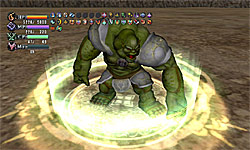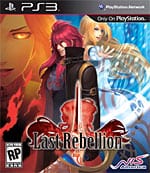Signed, Sealed, but Not Quite Delivered
NIS is, invariably, a publisher of some of the most enjoyable niche RPGs to ever come to market – Disgaea, Mana Khemia, GrimGrimoire to name but a few. Though the characters and story of their games aren’t always engaging, there are usually fresh gameplay mechanics to be found that breathe new life into the genre. With Last Rebellion, NIS and developer Hit Maker once again hit a vein of untapped gameplay gold, but does the adventure truly amount to a fortune?

Last Rebellion is a PS3 exclusive (sold at retail), and at roughly $50, it’s disappointing to see just how little effort has gone into the game’s presentation. The tale is told via still images, and though pretty much all of the dialogue is voiced, the story and lines are laughable at best. Nothing about this world is believable or interesting, and the way in which the characters act and react throughout the game is borderline offensive. Someone’s father is murdered right before their eyes, and the character’s reaction is merely one of subdued disinterest. The back-story is generic, the world is, figuratively speaking, paper thin, and ultimately, if you’re interested in this game for its storytelling, you should give Last Rebellion no further consideration.
If, however, you’re interested in a NIS-style spin on age-old, turn-based gameplay, Last Rebellion actually isn’t all bad. There’s a good bit of repetition, and the game often feels more like one long grind than an actual adventure, but it’s difficult not to be enamored by the game’s core ideas.
In Last Rebellion, you play as two characters who share one soul. One a Blade (Nine) and the other a Sealer (Aisha), the two protagonists must work together to defeat demons and, well, save the world/exact their revenge. Their relationship, alone, is a very interesting mechanic because, though you’re controlling the actions for two separate personas, they share the same health, mana and Chain Points (more on that in a bit). You can command the characters in either order during combat, and you’ll want to switch things up constantly in order to maximize strategy.

There are two main mechanics that make up the focus of battles: Attack Stamps and a bingo-style targeting system. It might sound weird – and, well, it kind of is – but these elements of the game make for some very satisfying combat.
Like most other RPGs, you have weapon attacks, offensive spells, and support spells. However, when executing regular attacks, you’ll first have to target specific portions of an enemy’s body. The idea is to target the body parts in a specific order, and when you discover the correct order, you get a “bingo,” which adds extra damage to your attacks. A typical monster might have seven to eight different body parts, and each attack uses a Chain Point. The catch is you can’t actually use offensive spells on enemies until you’ve stamped their body parts by using regular attacks. The closer you get to a bingo for each attack, the longer stamps will last. It’s an incredibly clever system, one that forces you to do a whole lot more than simply press an “attack” button over and over.

On the flipside, battles can sometimes drag on, and though there are shortcuts that allow you to memorize the bingo order for monsters, you’ll have to memorize them anew each time you enter battle. Still, the system is fun and rewarding, and it adds a surprising amount of freshness to such an old style of play.
Unfortunately, the game’s lackluster presentation forces all of the weight of enjoyment onto the combat. The sound effects and music have a very passive nature, and the monsters and animations are shamelessly recycled ad nauseam. Dungeons are simplified crawls through uninteresting landscapes, with no real breaks in the “same old, same old.” Boss encounters do little in the way of distinguishing themselves from regular battles aside from adding a fat health bar to the enemy.
Last Rebellion also falters a bit when it comes to its balance of difficulty. Enemies can often be brutal in the amount of damage they dish out, but you can easily replenish your HP and mana for free at any time outside of battle. As a sealer, Aisha must finish off enemies at the end of each battle, and you’ll gain additional health here as well.

Not all of the mechanics make perfect sense, either. You are guaranteed to seal an enemy once they’ve been knocked out, though you only have a slim chance of sealing them while they’re still alive. Since it costs nothing, however, to select all enemies on the battlefield for sealing, there’s never a reason to not select all enemies.
Lastly, you’re pretty much forced to fight every single battle you end up in, as your chances for “escape” are almost nil. A quirky experience system that rewards you with absolutely no experience for weaker enemies makes many encounters feel like a complete waste of time.
Though the production lacks almost any ambition or inspiration whatsoever, there’s nothing about Last Rebellion that truly looks bad. More has been done on Wii, but the game has a clean visual style to it overall. The atmosphere and vibe of the game, however, feel vacant, and without an interesting story or likable characters, you’re left with an experience that will likely only be enjoyable in very small doses.
If you’ve played your share of JRPGs or watch the Naruto animated series, you’ll likely recognize many of the voices in the game. It’s hard to pass judgment on the delivery by the actors, since the dialogue is so poorly written. But as a whole, the audio comes across as sedate and somewhat incidental.
Last Rebellion isn’t a bad game. In spite of a presentation that feels phoned in, the gameplay is, in many ways, fresh and entertaining. As a boxed retail product, however, it simply doesn’t cut the mustard. Fans of the publisher will likely have fun with the new ideas implemented into the game’s battle system, but the package feels like an overpriced casual game. Had NIS opted to bring the game to the PSN for $10-15, I could wholeheartedly recommend it. A few decent ideas plastered onto an empty shell, though, don’t come close to making this game a value. Curious fans might want to take a peek, but don’t be in a hurry to fork over your cash for Last Rebellion.
RATING OUT OF 5 RATING DESCRIPTION 3.4 Graphics
Though it’s hard to pick apart the game for being ugly, it’s easy to criticize the lack of effort put forth into the presentation. Cliché character models and monsters, ho-hum environments – Last Rebellion has no soul, really. 4.0 Control
Controls during overworld exploration and combat are fine-tuned nicely, though the battle system can get a bit convoluted at times. 3.4 Music / Sound FX / Voice Acting
Again, there’s nothing inherently bad about what’s on offer here; the audio just does so precious little to enhance the experience. 2.5 Play Value
The story and characters are a total wash, and the gameplay doesn’t change up much. It’s also a fairly short adventure for a console RPG. The battle system, however, is innovative and fun, sans a few extraneous additions. In the end, though, the package and the asking price don’t match up well. 2.9 Overall Rating – Average
Not an average. See Rating legend above for a final score breakdown.
Game Features:
